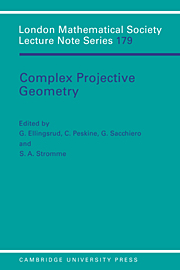Book contents
- Frontmatter
- Contents
- INTRODUCTION
- PROJECTIVE VARIETIES
- VECTOR BUNDLES AND SPECIAL PROJECTIVE EMBEDDINGS
- LIST OF PARTICIPANTS
- Speciality one rational surfaces in P4
- Bounding sections of bundles on curves
- The smooth surfaces of degree 9 in P4
- Compactifying the space of elliptic quartic curves
- Threefolds of degree 11 in P5
- Complete extensions and their map to moduli space
- On the Betti numbers of the moduli space of stable bundles of rank two on a curve
- Gaussian maps for certain families of canonical curves
- Geometry of the Horrocks bundle on P3
- Stability and restrictions of Picard bundles, with an application to the normal bundles of elliptic curves
- Sections planes et majoration du genre des courbes gauches
- A tribute to Corrado Segre
- Un aperçu des travaux mathématiques de G.H. Halphen (1844–1889)
- The source double-point cycle of a finite map of codimension one
- Fibré déterminant et courbes de saut sur les surfaces algébriques
- Courbes minimales dans les classes de biliaison
- Fano 3-folds
- Polarized K3 surfaces of genus 18 and 20
- Protective compactifications of complex afflne varieties
- On generalized Laudal's lemma
- Sur la stabilité des sous-variétés lagrangiennes des variétés symplectiques holomorphes
- Introduction to Gaussian maps on an algebraic curve
- Some examples of obstructed curves in P3
A tribute to Corrado Segre
Published online by Cambridge University Press: 06 July 2010
- Frontmatter
- Contents
- INTRODUCTION
- PROJECTIVE VARIETIES
- VECTOR BUNDLES AND SPECIAL PROJECTIVE EMBEDDINGS
- LIST OF PARTICIPANTS
- Speciality one rational surfaces in P4
- Bounding sections of bundles on curves
- The smooth surfaces of degree 9 in P4
- Compactifying the space of elliptic quartic curves
- Threefolds of degree 11 in P5
- Complete extensions and their map to moduli space
- On the Betti numbers of the moduli space of stable bundles of rank two on a curve
- Gaussian maps for certain families of canonical curves
- Geometry of the Horrocks bundle on P3
- Stability and restrictions of Picard bundles, with an application to the normal bundles of elliptic curves
- Sections planes et majoration du genre des courbes gauches
- A tribute to Corrado Segre
- Un aperçu des travaux mathématiques de G.H. Halphen (1844–1889)
- The source double-point cycle of a finite map of codimension one
- Fibré déterminant et courbes de saut sur les surfaces algébriques
- Courbes minimales dans les classes de biliaison
- Fano 3-folds
- Polarized K3 surfaces of genus 18 and 20
- Protective compactifications of complex afflne varieties
- On generalized Laudal's lemma
- Sur la stabilité des sous-variétés lagrangiennes des variétés symplectiques holomorphes
- Introduction to Gaussian maps on an algebraic curve
- Some examples of obstructed curves in P3
Summary
In this work we review some papers by Corrado Segre published during the eighties of the XIX century, when he was just above twenty. We believe that doing so may be interesting from the historical point of view as well as helpful to recognizing a link between methods of research used in those years (scarcely present in contemporary literature) and a number of results rediscovered (often without knowing it) in the current century. We thus try to reconstruct the origin of the path that has led to the modern theory of vector bundles on an algebraic curve.
Corrado Segre's programme
To appreciate the innovative character of the ideas put forward by the very young Segre, it is convenient to recall that in those years it was harshly debated upon the usefulness of studying Hyperspace Geometry. Some authors mantained that addressing the geometry of the hyperspaces was an unfruitful intellectual game not certainly helpful to understand the “real” geometry in two or three dimensions. On the other side, Veronese and Bertini at first, and then C. Segre were perfectly aware that not only the study of the geometry of hyperspaces would shed new light on the geometry of curves and surfaces of ordinary space, but also that these latter could be viewed – and this is certainly innovative – as points (defined by a number of parameters) belonging to new algebraic varieties that could not be placed in ordinary space.
- Type
- Chapter
- Information
- Complex Projective GeometrySelected Papers, pp. 175 - 188Publisher: Cambridge University PressPrint publication year: 1992
- 3
- Cited by



